
May 2005
Last Updated March 2025
|
 |
Caviar Glossary
Page 10: Tobiko, Whitefish Caviar, White Sturgeon & Other Terms From T To Z
This is Page 10 of a ten-page glossary. If you’d like to suggest additional words for inclusion or think we should consider other definitions than those we have provided, use the Contact Us link on this page. You may also enjoy one of our many other food glossaries, including a Sushi Glossary.
Click on a letter to get to the appropriate glossary page.
a b c d e f g h i j k l m n o p q r s t u v w x y z
This material is copyrighted and cannot be reproduced in whole or in part
without written permission. You are welcome to link to it.
|
TEXAS CAVIAR
Not caviar at all, but a dip made with black-eyed peas, tomato, onions, chiles and cilantro, red onion, and seasonings, served with tortilla chips. Here’s a recipe.
|
|
|
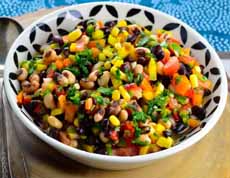
Texas caviar. Photo courtesy May I Have That Recipe.
|
|
TOBIKO or FLYING FISH ROE
A popular sushi ingredient, as both a garnish and in a gunkan-maki or “battleship roll.” Tobiko caviar comes from the flying fish of Iceland and the Pacific Ocean. Naturally orange in color with a nutty, smoky taste, it has a crunchy texture and more volume than capelin roe (masago). It is a superior product to masago, smelt roe, which is often passed off in restaurants for the pricier tobiko. The pale roe is often colored black, gold, green, or red. It is also spiced and flavored. Look for spicy orange tobiko, pale green wasabi-flavored tobiko, yellow citrus- and yuzu-flavored tobiko, and pale red ume (plum) tobiko. It can often be found in specialty food stores.
|
|
|
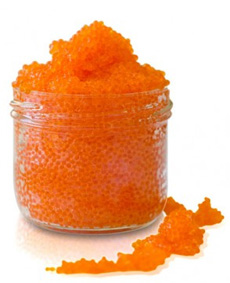
The natural color of tobiko caviar. It is often colored and flavored. Photo courtesy Pete’s Seafood Club.
|
TRANSMONTANUS REX CAVIAR
See white sturgeon, below.
|
OOO or TRIPLE ZERO CAVIAR
Caspian caviar is graded by color on a scale from 000 to 0. In this system 000 is the lightest, silvery pale grey; 00 is medium gray; and 0 is black. Although the taste is the same regardless of hue, the lighter caviars are more highly prized and priced than the darker ones. Thus, the rarest and most expensive caviar one could buy is Beluga 000 (assuming one was in one of the Caspian Sea border countries since export is banned). While not established scientifically, some industry experts believe that younger sturgeons produce lighter eggs. They would also weigh less and have less roe, which could account for the higher price. However, with the Osetra sturgeon, it is noticed that lighter color eggs come from older fish.
|
|
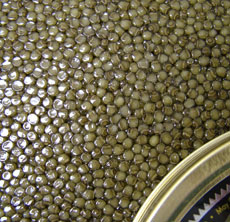
This Beluga caviar from CaviarStar.com earns a 000 rating for its beautiful grey color.
|
TROUT CAVIAR or TROUT ROE
From the Great Lakes of North America, trout caviar is an inexpensive caviar option. It’s yellow or orange, with a salty flavor and a somewhat sticky texture. A major producer is Sunburst Trout Farm in Canton, North Carolina, which cultures bright orange rainbow trout.
WHITEFISH CAVIAR or ROE
See golden whitefish caviar.
|
|
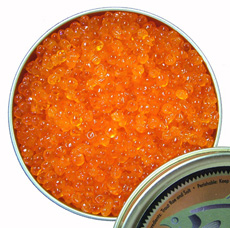
Trout caviar available at CaviarStar.com. |
YUZU KOSHO
Yuzu kosho is a Japanese condiment made from fresh chiles (most often green or red Thai or bird's eye chiles), then fermented with salt and the zest and juice from yuzu, a tart and fragrant citrus fruit that grows in East Asia. The trifecta of chiles, citrus, and salt unite in a paste used to enliven any savory dish, from sashimi to braised short ribs. It is a specialty of Kyushu , the third biggest island of Japan. You can buy it in jars, or make your own.
|
|
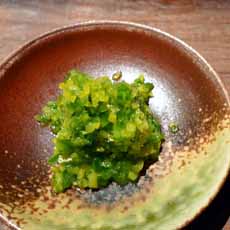
Here’s a recipe for yuzu kosho. |
WHITE STURGEON CAVIAR
The white sturgeon (Acipenser transmontanus, “sturgeon beyond the mountains”) is an American sturgeon, also known as the California white sturgeon, Columbia sturgeon, Oregon sturgeon, Pacific sturgeon, and Sacramento sturgeon, after the many locales where it is found. It lives wild along the west coast of North America from the Aleutian Islands to Central California and was originally found as far south as Mexico. It is being farmed in California, Idaho, France, Israel, and other locations. The fish is related to the Caspian Osetra sturgeon (Acipenser gueldenstaedtii) and the caviar is similar; depending on its origin and terroir, flavors will vary.
|
|
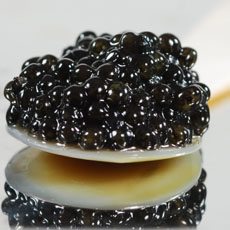
White sturgeon caviar. Photo courtesy of BackyardGardener.com. |
The Israeli-farmed white sturgeon caviar we have tried has had the closest similarity to Caspian Osetra. But perhaps our favorite caviar, now that Caspian is for all intents and purposes gone, is the Transmontanus rex (“King of the White Sturgeon”). This sturgeon from Idaho has hints of beluga flavor and is caviar heaven. While a record 2,000-pound, 20-foot “T-Rex” was found in Idaho’s Columbia River, the fish in the farms tend to range from 100 to 200 pounds at caviar harvest. See American sturgeon caviar/California osetra caviar.
See also American sturgeon caviar.
Go To The Alphabet Index Above
Lifestyle Direct, Inc. All rights reserved. Images are the copyright of their individual owners.

|